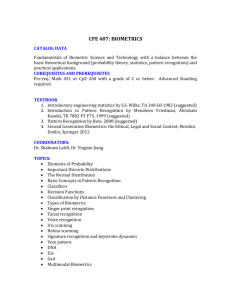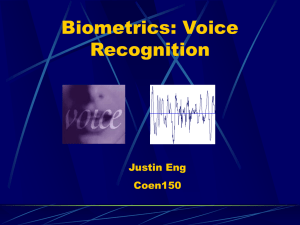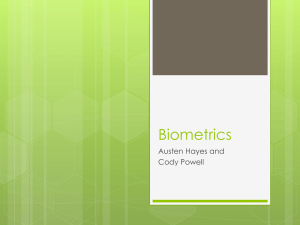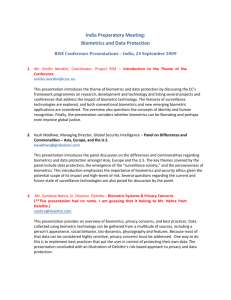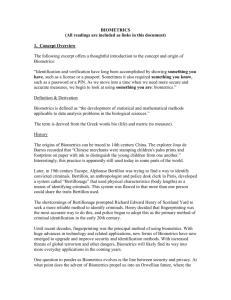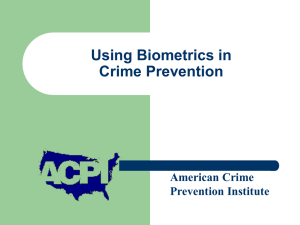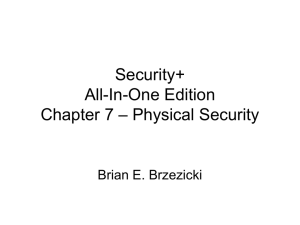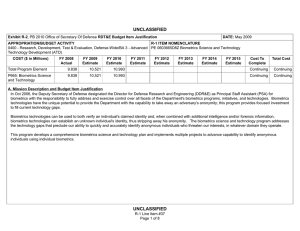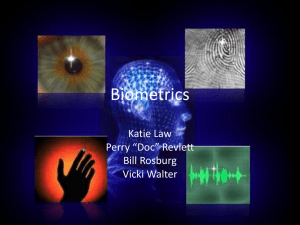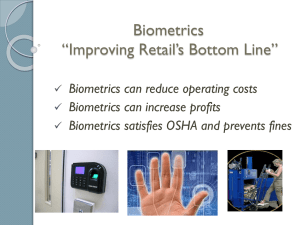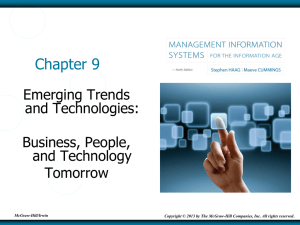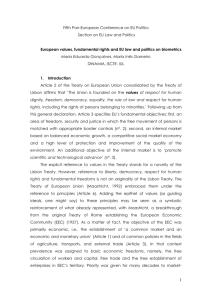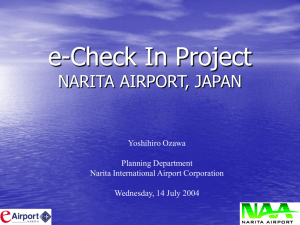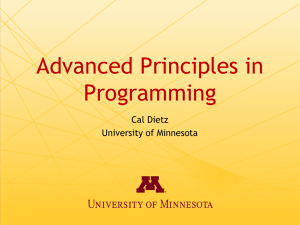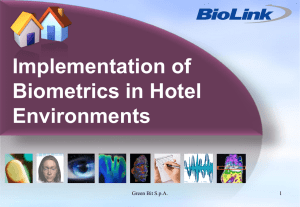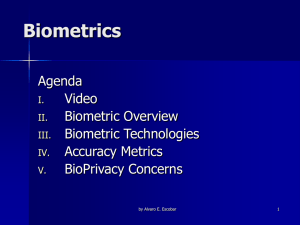Biometrics, Identity and Development
advertisement
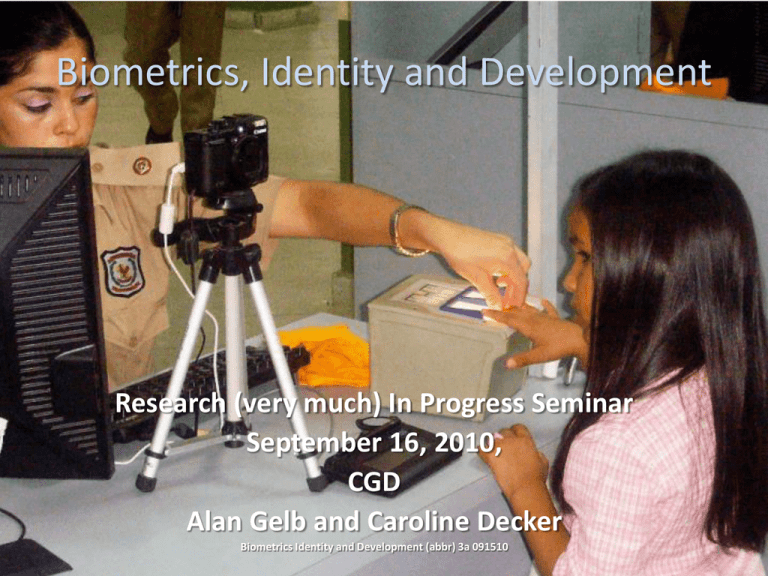
Biometrics, Identity and Development Research (very much) In Progress Seminar September 16, 2010, CGD Alan Gelb and Caroline Decker Biometrics Identity and Development (abbr) 3a 091510 1 Biometrics is not uncontroversial “The wasteful, bureaucratic and intrusive ID card scheme represents everything that has been wrong with government in recent years.” ~ UK Deputy Prime Minister Nick Clegg (2010) “Privacy is dead, get over it.” ~Scott McNealy, Sun Microsystems (1999) Leapfrog technology, very relevant to development 2 Introduction • Original motivation : cash transfers of resource rents to citizens Identification is essential • But: – Identity is a much wider issue than transfers. Part of development process. – Huge Externalities to Identity – Growing number of bio programs in developing countries + new BIG player – Range of policy and coordination issues: governments, donors, private sector • No overall summary… • Objectives? Beyond a paper? 3 Outline of presentation • • • • What is biometric identification? Some system options Five +1 case studies Issues and debates on biometrics • The future of biometrics and development • Next steps for research? 4 What is Biometric Identification? Identifying someone based on unique physical or behavioral trait • Identifiers – – – – – – – – – – – – – – Fingerprints Palm prints Footprints Vein mapping Hand geometry Face prints Earprints Retina Iris scans Tongue prints DNA Voice prints Gait Dynamic Signature • Possible uses – – – – – – Security Criminology Anti-terrorism Crowd recognition Immigration General identification for economic purposes • Different levels of precision and intrusiveness 5 Fingerprints • Ancient: 650 BC speculation unique • 150 years used for criminal forensics; digitization in 1990s 40 different points • Simple readers $30 • Accuracy: 99.9% -95% (latent prints, less) • Early capture age about 12 • Susceptible to wear, damage • Potential to be fooled in lab conditions 6 Iris • • • • • 1994 John Daugmann Iriscode algorithm 266 digital feature points, still rapid comparison rate Very accurate: Prob 2 identical 1 in 10e78; 99% + Stable by 8 months. Eyes self cleaning Fooled by pictures in labs newer readers also check for living eye • Does not involve physical contact • Readers $4,000 but quickly becoming cheaper 7 Some System Options 1 Universal vs. Programmatic Adoption • • • • • • Universal ID Project Typical national ID project • Malaysia, Costa Rica, India, Many applications Economies of scale Concern for security Big Brother State? Upfront cost before benefits • • • • Programmatic ID Individual projects • DRC, Malawi, KZN, Gujarat Smaller budgets; cost vs. savings Potential externalities Need for planning and coordination 8 2 Payment Options for Cash Transfers Pull – Payment at specific time and location – Allows dissemination of information and services at the same time – Less convenient for staff and recipients – Example: DRC (final method: mobile pay stations) Push – Financial account necessary, possibly e-banking – Convenient - cash accessible anytime in numerous POS, merchants etc – More expensive to set up, but cost effective long term – Examples: Namibia, Botswana (ATMs), South Africa (Sekukula account) 9 Methods of Payment • Cash – Risky: concentrated cash – No saving/banking options – Requires pull mechanism • Vouchers – Allow for saving, but not banking – Requires pick up, pull payment – Safer: no cash on hand at distribution • Smart Card – Can use pull or push payments – Allows for saving, not necessarily banking • Bank Direct Deposit (mobile banking) – Offers externality of banking services – Push payment service 10 3 Identity Validation • Pure Biometrics • • • • • • Constant through life Cannot be shared Does not require literacy Nothing for recipient to lose Cheaper, no smart card Doesn’t support offline push system • Smart Card • Photo ID 11 3 Identity Validation • Pure Biometrics • Smart Card – Information on card, offline system. Validation with either bio ID and: – Pin • Readers cheaper • Can be used remotely • Can be reprogrammed when compromised • Can be shared or stolen • Harder for illiterate populations • Photo ID 12 3 Identity Validation • Pure Biometrics • Smart Card • Photo ID – Requires human interface, more susceptible to error – Easier to forge or fake – May appear cheaper than biometrics or smart card 13 Five +1 Cases: Afghanistan/Pakistan (UNHCR) • • • • • • Objective: Resettlement payments Over 200,000 refugees processed Began 2002 Iris scans before payment Prevented round-tripping Most basic use of biometric ID “It has proven very successful, meeting not only cultural needs of the refugees but the operational requirements of UNHCR.” 14 DRC (World Bank) • • • • • • Objective: demobilization payments 102,000 soldiers 13 payments over one year Iris scans for registration Push system later Pull system Banking system not set up in time for full use • Sparse rural areas 15 Malawi (DFID/Concern) • • • • Objective: cash relief after drought 2006 (DECT) 11,000 households, only lasted five months Fingerprinting for both registration and payment Smartcard bank based system but bank not fully geared up so manual payment. • Biometrics not immediately cost-effective due to careful selection process, small scale, short term. 16 4 South Africa KZN (Government) • Objective: pensions and other social payments • 1990: first such known use of biometrics • 5 million grants delivered per year • Fingerprints for both registration and payment • Modified Pull payment, fixed and mobile centers. Developed into Push system • Extended nationwide; also to Namibia • Apartheid fingerprinting grants to poor 17 5 a India (Andhra Pradesh Gov’t) • • • • Objective: Employment Guarantee and Pensions Replaced traditional well-run system. 5 million people Fingerprints, smartcards, Push payment system, pure bio Convenient, little to no leakage 18 5b India Unique ID (UIDAI) • Nationwide, multifunction program, Largest in world. ID only. • Registration underway, fingerprint and iris, not yet compulsory…. • Using international standards, potential to bring down costs sharply for all countries • Payment systems will use Push system with POS 19 Debates on Biometrics 1. Too Costly? • Basic registration: Enrolment station hardware 10c/ person.. • Sao Tome 160,000 ; 5 stations cover in 2 years • Haiti 10 million; • 200 stations cover in 3 years • National ID Costa Rica $1.11/per person; India $5; South Africa $10 • Overall costs of applications need to include technology; single smartcard can cost $2 + 20 Are There Potential Savings? • Africa: PETS leakages 30% - 60%, wages 20% Chad 98% • Southern Africa: Pension theft, ghost workers in KZN…reported savings up to 20% in Namibia (NET1) • India: Andhra Pradesh bio showed prior losses of 12% ; other states 30%; one state 70% • India: Estimated loss of 40% social payments ($110 billion). Two thirds corruption, rest misdirection. Only 15% reaches poor. • USA programs lose $4 billion to welfare double dippers each year Biometrics cannot solve all problems including those related to targeting, but can reduce leakage. Losses very low. • “Technological approaches are more expensive to set up, but more costeffective in the long run, not least because they have greater potential for multiple applications.” Innovations Report, Malawi 21 Potential Savings (India) Expected leakage of government's funds likely to be spent over next five years Rsbn 3500 58% 3000 48% Reaching the Deserved 2500 30% Leakage 2000 50% 1500 38% 1000 500 25% 0 Food NREGA Kerosene Midday Meal Petroleum (ex Kerosene) Fertiliser 22 Can Bio be Used in Difficult Conditions? • Technology will be difficult for rural populations? No. – One hour of training needed in DRC for operators – “Clients adapted well to technology” ~Malawi report • May be easier than traditional ID methods – Different spellings of names – PINs higher-risk – Tokens or books are often lost • Some applications do need mobile communications but spreading 23 Civil Liberties or Public Accountability? • Major concern in developed world, and in views of some in developing countries • But opposing view: less liberties to erode, strengthens citizens against rapacious officials • Some NGOs note the increased transparency of programs strengthens accountability • What privacy and civil liberties are low-income citizens likely to lose? 24 Undermines “Human” Approaches? • Direct transfers weaken community structures? • Offset: possibility of local taxation strengthening representation – See Saving Ghana from Its Oil (Moss and Young) • Weakens bureaucracy and less face-time for citizens? • Offset: depends on quality of governance • Political economy of Bio-ID including for transfers ? – Bypasses major chunks of bureaucracy. – But potentially closer connectedness to the state because programs work? 25 Data Integrity for Future? • Will data still be secure in 20, 30, 40 years? 26 Questions for the Future BIOMETRICS IS COMING. • How do we maximize its development potential? • Programmatic introduction in LICs often associated with donor programs. Potential for huge saving in efficiency, especially in less functional states. • Opens the door to better approaches. Haiti? Pakistan? • How to maximize externalities , towards a more coordinated approach and international standards? • Survey paper + ? CGD? • Encourage research. • Little rigorous exists…. 27 END 28

